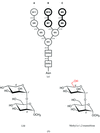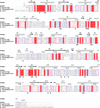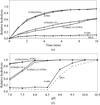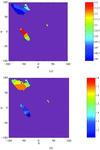issue contents
March 2008 issue

Cover illustration: The multiple-conformer model of Tyr33 with the maximum-entropy method (MEM) charge density. The MEM charge density is shown as a grey mesh. The difference MEM charge density is shown as a red mesh. The charge-density levels are 0.70 e Å-3 for the MEM map and 0.40 e Å-3 for the difference map (p. 237).
research papers
The structure of P. citrinum α-1,2-mannosidase has been determined at 1.95 Å resolution in complex with methyl-α-D-lyxopyranosyl-(1′,2)-α-D-mannopyranoside.
An accurate structural refinement using the maximum-entropy method (MEM) is reported. The reliability factor Rfree in the SHELX refinement was reduced from 18% to 10% by model building based on MEM charge densities.
L-Asparaginase from Er. carotovora belongs to the family of bacterial amidohydrolases and catalyzes the conversion of L-asparagine to aspartic acid and ammonia and, to a lesser extent, the formation of L-glutamic acid from L-glutamine. The highly homologous L-asparaginases from E. coli and Er. chrysanthemi are widely used as effective anti-leukaemia drugs. Like the majority of L-asparaginases, ErcA also reveals antitumour activity, but differs from EcA and ErchA in antigenic specificity. Therefore, ErcA is of special interest as a potential therapeutic agent and as an enzyme suitable for drug development.
A study of the specificities of divalent metal cation-binding sites in proteins with known three-dimensional structure is presented.
Download citation


Download citation


Radiation-damage-induced phasing of PdII-bound and CuII-bound complexes of an 18-residue peptide with two disulfide bonds derived from the neurotoxin apamin rested on the differential susceptibility of radiation-sensitive groups in non-isomorphous lattices.
The crystal structure of human monocyte chemoattractant protein 4 (MCP-4), a member of the CC chemokine family, has been determined at 1.70 Å resolution.
PDB reference: human monocyte chemoattractant protein 4, 2ra4, r2ra4sf
The first crystal structure of human argininosuccinate synthetase is presented and is compared with its bacterial counterparts.
PDB reference: argininosuccinate synthetase, 2nz2, r2nz2sf
The glycerol concentrations necessary to vitrify 1536 high-throughput crystallization-screening cocktails have been determined in order to aid rational prioritization of crystallization leads observed in these cocktails. The concentrations were made by dilution rather than by the replacement of water with glycerol. They therefore serve as a worst-case scenario.
Combined mutagenesis and X-ray analysis have been used to attempt to understand the diametric difference in the biotin-binding properties of avidin and streptavidin.
Several crystal forms of E. coli asparaginase/isoaspartyl peptidase (EcAIII) can be obtained under essentially the same crystallization conditions. They all have P212121 symmetry with similar unit-cell parameters, but show non-isomorphous crystal packing.
PDB reference: T179A mutant of EcAIII, 2zak, r2zaksf
The structure of a second form of aspartate semialdehyde dehydrogenase from V. cholerae has been determined from crystals grow through optimization of the starting buffer conditions. The similarities and differences between isoforms are discussed from both a structural and a functional perspective.
short communications
The crystal structures of D-amino acid amidase complexed with L-phenylalanine and with L-phenylalanine amide reveal three factors related to its D-stereospecificity.
letters to the editor
Free 

A suggestion is put forward concerning the stereochemical restraints debate.


 journal menu
journal menu





























